SPEED RACER: The Wachowski’s Misunderstood Masterpiece
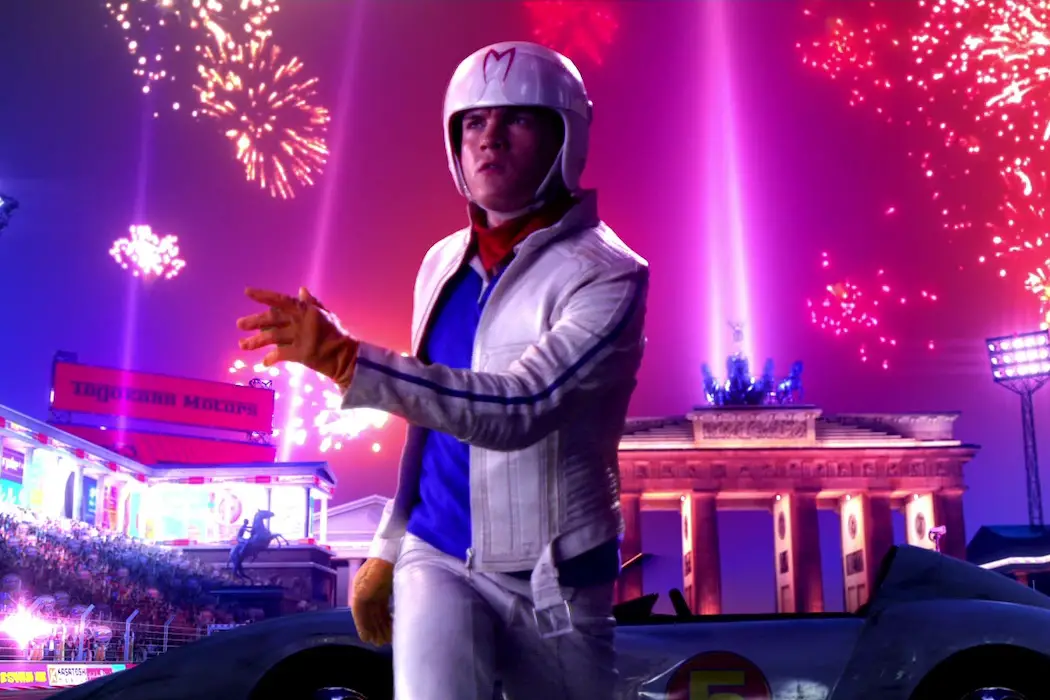
If there is one word that can sum up Dallas…
In 2008, The Wachowski Sisters released a live-action adaptation of the once-beloved sixties Japanese animated series Speed Racer. At the time, it was a box office and critical failure. Many critics called the film garish and the special effects stylish but empty. The plot had no substance; Speed Racer was a movie with a budget of 120 million that only made back 93 million at the box office.
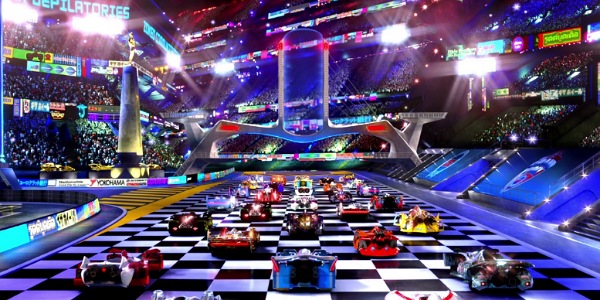
As of late, however, there has been a resurgence of appreciation for the film. Speed Racer has developed a strong cult following with reappraisals. Some critics online have revisited the flashy remake to see it in a better light. Such reframings are nothing new for movies. Films once considered flops have found new audiences and are now considered classics.
Other cult classics such as Donnie Darko and Fight Club were panned critically and financially but are now picked apart and analyzed by film nerds and loved by many.
But, To Be Fair..
It is a begrudging admission, but the Speed Racer haters do have a point.
Clocking in at a run time of 130 minutes, Speed Racer is excessive. I know very few kids who could sit that long in front of a movie for a film marketed towards a younger audience. Most would fidget, feeling the urge to get up off their butts, in fits of pent-up antsiness. No matter how many pretty colors, over-the-top races, and cool fights, kids-will-be-kids and most do not have the mettle for a film over two hours long. Know your audience, Wachowski’s.
Trimming off a good thirty minutes might have led to the film being more successful with viewers.
Speed Racer also seems to suffer from a storytelling identity crisis from time to time. The plot is full of intrigue, filled to the brim with discussions of corrupt corporate politics, rigged races, and how Speed must win the race to bring about justice—for the future of racing! Although handled adroitly at times, some dialogue adds to the tonal whiplash of seriousness, especially for a movie that is so colorful and vibrant in its presentation. The Wachowski’s shot too high, plot-wise, for a family film.
Why Did Speed Racer Fail At The Box Office?
Despite the agreed-upon criticisms that I have of the film, the failure of Speed Racer, I believe, can be summed up for three reasons. Number one, it was ahead of its time in many ways. Two, it was based upon a property that had fallen by the wayside even though it was popular a few decades ago. And three, the release timing was a series of poor choices.
Avant-Garde is a term used for an artistic work that goes against the grain, moves off the beaten path of social acceptability, or is otherwise unorthodox. Speed Racer was ahead of its time in that way. Most movie-going audiences sought ‘realistic’ films that had a more cynical edge in storytelling and themes. And here he comes, here came Speed Racer. It revved onto the theatrical scene with an unapologetic bright demeanor and an old-fashioned story of the good guys beating the bad guys.
Such storytelling is considered passé, childish, naive. And while there is something to be said for darker themes in movies, sometimes viewers need a film with an optimistic spirit.
While the original animated series was popular with boomers in the 60s and 70s, Speed Racer, more or less, was forgotten by the world outside of retro cartoon aficionados. To release an adaptation of a cartoon that has been relegated to the dust bin of animation history; was a foolhardy move, risky. It was a risk that met with a financial failure for The Wachowski’s. It also did not help that Speed Racer was released a mere week after the Marvel Studios juggernaut, Iron Man.
Two months later, Speed Racer and Iron Man were trounced in the collective movie-goers subconsciousness by the Dark Knight. And in one box-office swoop, Speed Racer was dismissed.
But in spite of the failure and harsh criticism, is Speed Racer worth a second look? Is there a classic hidden beneath the glitz and bombast of this failed remake? Or is this just the biased take of a confirmed anime dweeb? The answers are yes, in a way, and absolutely! Speed Racer is The Wachowski’s misunderstood masterpiece.
Speed Racer is Color
From the very first shot, The Wachowski’s give the viewer no quarter. The kaleidoscopic swirls of colors and brightness can be jarring—but that was an appetizer for the rest of the movie. It was as if to tell the viewer that they are in for something they have never seen before, no punches pulled and any beating around the bush. Speed Racer is color and lots of it! From the 2000s onward, films took the turn for more realistic visuals, complete with muted hues and light to give the viewers a sense of realism.
The Wachowski’s followed this formula as well. Looking at The Matrix Trilogy, for example; the entire setting is draped in muddy, almost earthy tones of green—characters all draped in black and an overall dour cyberpunk setting. Contrasted with Speed Racer, where all things are bright and every color-popping, filled to the brim with a vibrancy that few modern films dare even try. While other films of 2008 aimed to represent the real world as close as possible, Speed Racer took a sharp turn for the imaginary realms of the zany and fantastical.
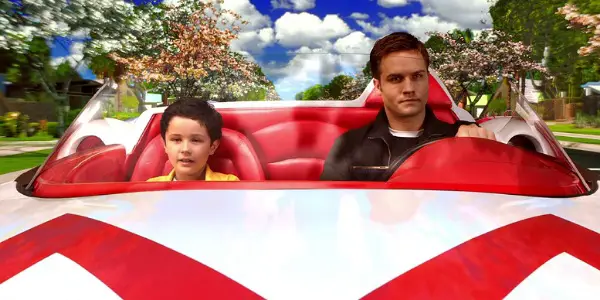
Speed Racer is an exhibition of pure style: candy apple reds, bright azure skies, neon-like yellows, iridescent whites, whatever color the reader can muster up within. The whole film feels akin to what would be in a technicolor romp from the 1960s, not a post-millennium action film. In hindsight, the entire project feels like it belongs in the 60s. The Racer household looks like The Brady Bunch lives there.
Many of the characters dress as if they stepped out of a 60s suburbanite’s closet. The world of Speed Racer has a retro-futurism aesthetic that feels more of what people of the 50s and 60s thought the future would be. It’s a kind of sunny optimism and all of the goofiness that comes with such a bright disposition. While a lot of cinema (especially nowadays) is stuck in the realm of the dark and gloomy, Speed Racer is all bright and peppy. There is a candy-coated charm in it all, a bonafide live-action cartoon done almost in entirety through the use of green-screen effects.
As for the races themselves, every zip on the road ignores the bounds of reality and throws all caution to the wind. Races are pumped full with a sugar-rush of energy, like giving a group of children in an empty room with some crayons, paint, and toy cars. And then telling them, “do whatever you want!” this is the cinematography of Speed Racer in a nutshell.
Cars careen and zoom along like hot wheels on a track that jumps into the air only to land in an explosion of light and vibrancy. While being a bit eye-straining at times, I would be lying if I said I was not thrilled by the whole spectacle. I saw fancy race cars doing “car-fu” in midair as our heroes screech to the finish line, and the boy in me cheered. It was like experiencing anime for the first time again.
Speed Racer is Sincere
While being a big-budget Hollywood adaptation, Speed Racer is far from a mere cash grab. The Wachowski Sisters are familiar with showing off their love of anime. After all, The Matrix is a giant love letter to both Akira and Ghost in the Shell. But with Speed Racer, it goes from being a love letter to becoming the whole post office of going gaga for all things anime.
While revamped and revised for not only the big screen but also a modern audience, the source material still maintains its spirit and message. The overall moral message of the original Speed Racer was a simple one: cheaters never prosper. For the Racer Family, winning is important, but not at the expense of integrity and good sportsmanship. Racing to them is like a religion that should be honored and beheld with reverence, like the love of the track that the Racer’s have; the Wachowski’s have an obvious affection for anime.
Speed Racer showcases plenty of references to the art form. Sprinkled liberally about, the references to anime abounds. Everything from speed lines during certain action scenes, in-your-face fight scenes, and a complete refutation to the laws of physics! Even some nods to anime series having nothing to do with Speed Racer (A shoutout to Ranma ½ snuck in for fans with a keen eye) are present.
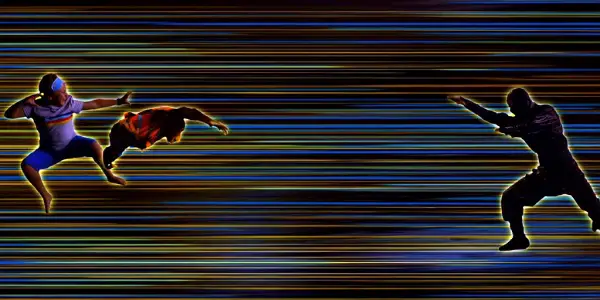
Many adaptations—especially those marketed towards a younger audience—try to chock the whole production full of modern-day references. More often than not, these make the film become dated soon after the release and cheapen the exhibition as a whole. It is an irritating filmmaking trap that Speed Racer swerves past. The Wachowski’s made this movie for their love of the source material. Although Hollywood filmmaking—in the grand scheme of things—is a business, the viewers can tell that Speed Racer has some sincerity behind it all.
As for the Racer family themselves, It is nice to see a family that does not fall into the same pitfalls seen at a nearly constant rate in other media. Most media nowadays have the trademark dysfunctional family tropes. It’s almost always dumb dads and condescending moms. But not here. How about the tired plot device of intrusive thick-headed in-laws and friends? Nope. Bratty and overly precocious kids who are always trying to one-up their parental figures? Very little. Speed Racer takes a refreshing turn against those tropes by showing a supporting and loving family. They build up instead of tear down.
Although there might be squabbles at times between them, as well as past family tragedies—the Racer’s stick together. They remind me of a light-side version of The Addams Family, always doing their own thing with a flare of fierce individualism.
One aspect of the sincerity of Speed Racer, in all honesty, is a double-edged sword. The main villain’s introduction—E.P. Arnold Royalton—an automotive industry tycoon and corrupt businessman. The Racer family is an independent automaker. As Pops Racer states early in the film, it remains as such because, well, corporations are evil.
In a sense, this is a heavy-handed finger-wagging towards big business. Preachy in the message of how corporate interests can destroy something (in this case racing) that should be done purely for the thrill and enjoyment, not money. The irony is that a major corporation produced Speed Racer, so there is a bit of hypocrisy in symbolically biting the hand that feeds. However, The Wachowski’s are famed for making films with protagonists rebelling against the powers that be—whether it’s a technocracy (as in the case of The Matrix) or a major corporation that rigs races.
Speed Racer Has Superb Casting
The casting of this film is perfect, with none of the members feeling like they are phoning it in for a paycheck.
Emile Hirsch as Speed Racer is the right balance of wide-eyed love of racing while retaining some of that rebellious spirit as was showcased in the original series. Unlike his animated counterpart, who was more headstrong, the film adaptation version shows us a more unsure Speed. There is a twinge of insecurity. For all of the zany visuals on screen, such tweaking of the main character makes him feel more grounded in an otherwise cartoonish world.
John Goodman is a dead ringer for the strict but otherwise loving Pops Racer in both spirit and appearance. Susan Sarandon, as Mom Racer, is always there for her family to provide moral support. She gives one of the best mom pep talks in a pop-corn movie when Speed is feeling down in one scene. Matthew Fox plays one of the corniest masked vigilante characters, Racer X. But he never feels like he is not giving it one-hundred-and-ten percent, even though his brooding acting inspires a series of chuckles.
Paulie Litt, as Sprittle Racer, plays the pesky but good-natured youngest member of the family. And right beside him is his pet chimp, Chim Chim in-tow. Don’t ask why the Racer Family has a pet chimp; they just do. Kick Gurry, as Sparky, was more of an afterthought who didn’t leave much of an impact—not a bad character, and he even has his comedic slapstick moments. For the most part, he is the weakest character and is just there for the camera.
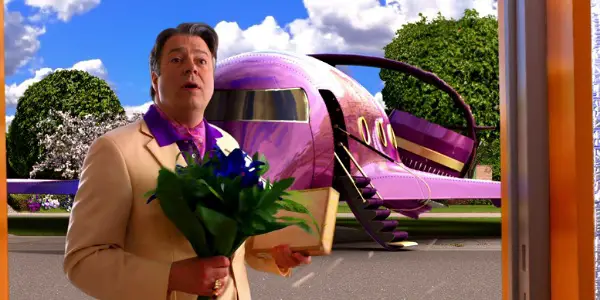
However, the two cast members who stole the show were Christina Ricci as Trixie and Roger Allam as E.P. Arnold Royalton. In her own right, Ricci almost looks like an anime girl with a cutesy demeanor and the ubiquitous large doe eyes. Coy but also knows how to be a bad-ass when the plot calls for it. The trope of the cute girl fighter is a familiar trend in anime, and the live-action Speed Racer capitalizes on that.
As for the villainous E.P. Arnold Royalton starts as a charming Englishman with a dapper suit. He comes bearing plenty of gifts and smooth talk from his introduction to lull the Racer family into a false sense of security in hopes they will join his company. But his true nature as a mustache-twirling bad guy comes out when Speed sticks to his guns and refuses his offer. Although the build-up to establish Royalton as the villain takes a bit too long, it is still fun to see Allam chew up the scenery with cartoonish bad-guy antics.
Speed Racer Tells A Story
One of the problems of filmmaking is how to tell the most compelling story. One of the rules of thumb for making a movie is show-don’t-tell. And while The Wachowski’s have no issue with heaping storytelling dialogue in their films (Matrix: Revolutions, anyone?) Speed Racer sets up the characters and the world they inhabit. This setup is done with skill in the first sixteen minutes of the film.
The viewer learns of Speed’s past, his motivations, how he met Trixie, and the tragedy of losing his brother, Rex. There are moments where the cast drone on a bit too much, and all for the sake of keeping the viewer up to pace plot-wise. But the way Speed Racer uses its visuals to tell a story makes it work.
Implementing traditional anime cues, The Wachowski’s can show different perspectives all at once by depending upon a variation of a classic anime trope: the split-screen. They are not done in the same way as shown in many anime but producing the same effect. Speed Racer keeps the storied perspectives flowing—especially when something tense is going on. An example of this is from the opening scene, while Speed is racing as the announcers give their commentary. Moving across the screen as if the whole spectacle was one continuous shot, never breaking momentum and keeping the audience engaged.
While detractors may say that the swiping-characters screen effect of the movie is obnoxious, it certainly lives up to the speed aspect of Speed Racer. Fair warning, this might not be a good film for people with epilepsy, but The Wachowski’s understand anime visual motifs and put them to good use. If The Simpsons taught us anything, Seizure Fighting Robots are cool!
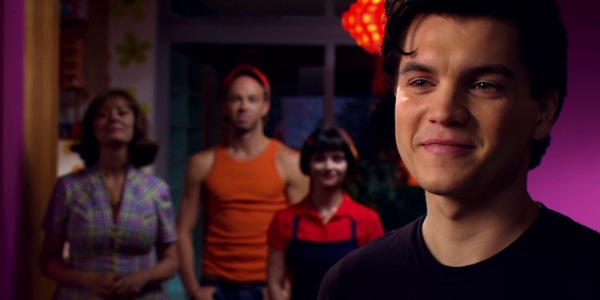
For many films, the musical score adds to the story just as much as the visuals do. I am willing to go out on a limb to say that this is one of Michael Giacchino’s best compositions. Every piece has a rollicking high-energy charm to it that harkens back to the ‘gee-willickers’ bygone era of retro movies. Some of the musical pieces seem reminiscent of the old-school James Bond movies. This makes sense since the whole film is filled with futuristic gadgets like an old-school James Bond flick. 007 would have killed to have The Mach 5 as his car of choice on one of his missions!
Conclusion: Speed Racer is Worth a Look
Speed Racer is worth a second look beneath the gaudy visuals, the breakneck speed of storytelling, and the somewhat over-extended run time.
Speed Racer has what a lot of adaptations lack, a respect for the source material. Many geeks and nerds complain about adaptations being butchered, forced to be rent asunder for a quick buck. And while some of that complaining might come from a place of fan-entitlement, agreements must be made. Some films based upon beloved franchises miss the entire point of their source material, empty shells lacking their voice or, at least, adding their voice to the original as a proper homage.
While not everyone’s cup of tea, Speed Racer is an avant-garde film with an unmistakable style and dares to take risks. Maybe, if released nowadays, it might have revved up some love since nostalgia is king in the 2020s. But this feature is not alone in its praise of this movie. Speed Racer has become a cult classic in its own right. And while, to some, using the word masterpiece to describe it probably be a stretch, the fans in the stands are chanting with enthusiasm, “Go, Speed Racer, go!”
Give it a second viewing and see if you’ll add to the chant.
What are your thoughts? Have you seen Speed Racer? Do you like it, or do you think this is a film only for anime fanboys? Let us know in the comments below!
Watch Speed Racer
Does content like this matter to you?
Become a Member and support film journalism. Unlock access to all of Film Inquiry`s great articles. Join a community of like-minded readers who are passionate about cinema - get access to our private members Network, give back to independent filmmakers, and more.
If there is one word that can sum up Dallas Marshall, it would be weird. He is a strange fellow who is also a writer, anime nerd, and film buff who can also talk for hours about mythology and out-there literature. He has been sighted at local used bookstores perusing for horror books and manga. He has also written a book about Japanese animation called Anime Adrenaline! Which can be found on Amazon. You can also catch him on his own website at www.Dallasthewriter.com













